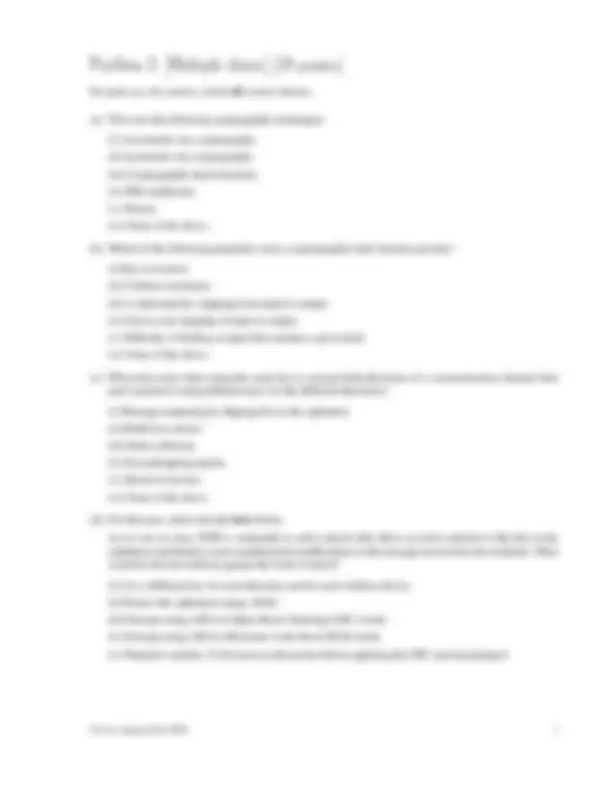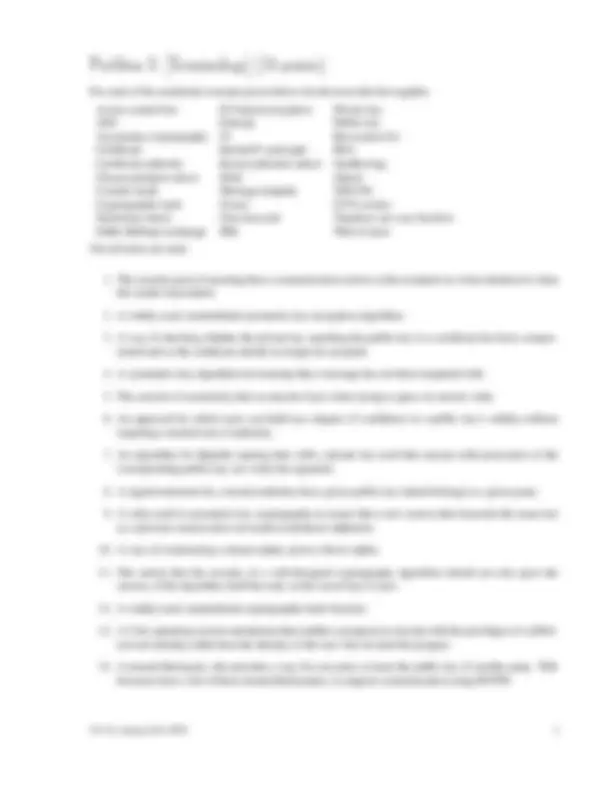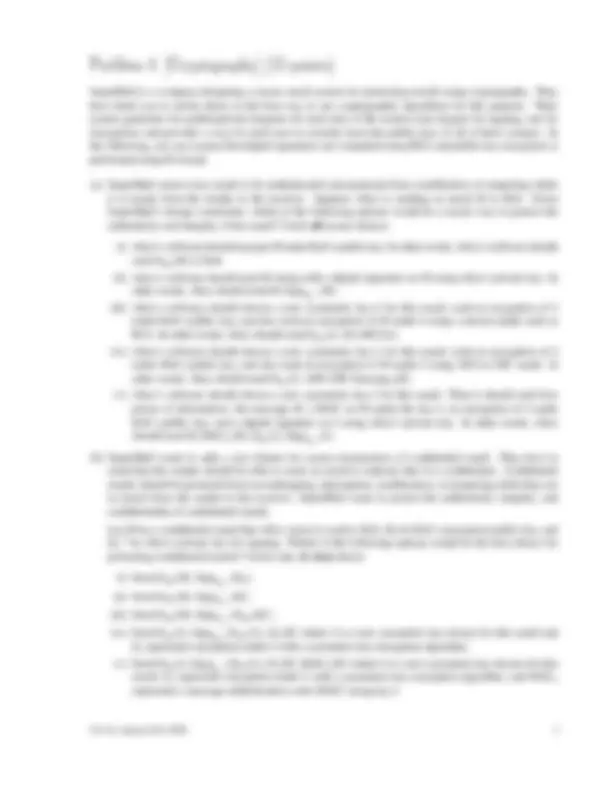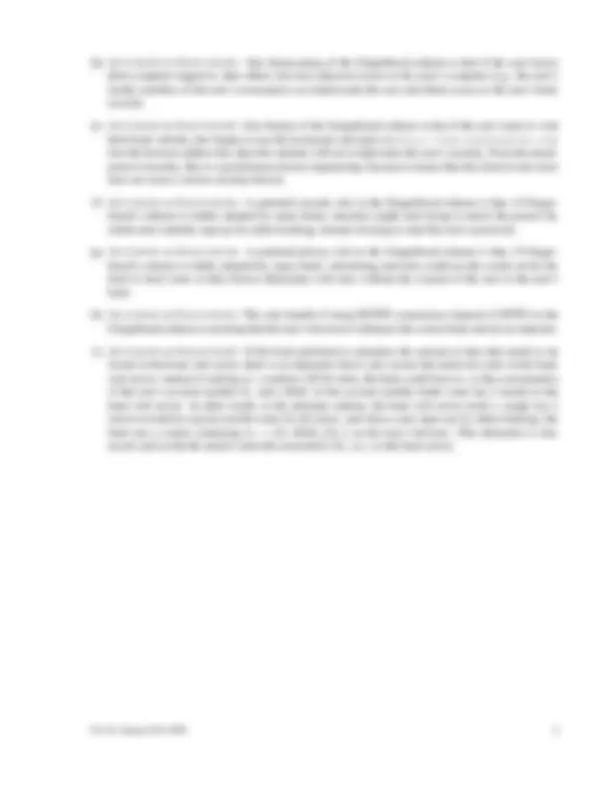






Study with the several resources on Docsity

Earn points by helping other students or get them with a premium plan


Prepare for your exams
Study with the several resources on Docsity

Earn points to download
Earn points by helping other students or get them with a premium plan
Community
Ask the community for help and clear up your study doubts
Discover the best universities in your country according to Docsity users
Free resources
Download our free guides on studying techniques, anxiety management strategies, and thesis advice from Docsity tutors
Main points of this exam paper are: Asymmetric Cryptography, Public Key, Symmetric Key, Memory Protection, Operating System, Typical Operating, Malicious Code, Kernel Mode, Pki Certificates, Key Revocation
Typology: Exams
1 / 8

This page cannot be seen from the preview
Don't miss anything!





PRINT your name: , (last) (first)
SIGN your name:
PRINT your class account login: cs161-
Your TA’s name:
Your section time:
Name of the person sitting to your left:
Name of the person sitting to your right:
You may consult one sheet of paper (double-sided) of notes written for this midterm, plus the sheet of paper you brought to midterm 1. You may not consult other notes, textbooks, etc. Calculators and computers are not permitted. Please write your answers in the spaces provided in the test. We will not grade anything on the back of an exam page unless we are clearly told on the front of the page to look there.
You have 80 minutes. There are 6 questions, of varying credit (100 points total). The questions are of varying difficulty, so avoid spending too long on any one question.
Do not turn this page until your instructor tells you to do so.
Circle TRUE or FALSE. Do not justify your answers on this problem.
(a) TRUE or FALSE: If Alice has a message to send to Bob and she wants to encrypt the message using asymmetric cryptography so that no one other than Bob can read it, she does so by using Bob’s public key.
(b) TRUE or FALSE: SSL and TLS provide essentially the same end-to-end security properties.
(c) TRUE or FALSE: Properly used, a MAC provides both confidentiality and integrity.
(d) TRUE or FALSE: DNSSEC uses SSL between different name servers to certify that the results of DNS queries match those that the name servers are authorized to provide.
(e) TRUE or FALSE: In the United States, if a company posts a privacy policy on their web site and fails to comply with it, they can be prosecuted for false advertising.
(f) TRUE or FALSE: An attraction of public key cryptography is that, if implemented properly, the algo- rithms generally run much faster than those for symmetric key cryptography.
(g) TRUE or FALSE: Memory protection, as found in a typical operating system, prevents malicious code running in kernel mode from writing to application-owned pages.
For each of the numbered concepts given below, list the term that best applies:
Access control list El Gamal encryption Private key AES Entropy Public key Asymmetry cryptography IV Revocation list Certificate Kirchoff’s principle RSA Certificate authority Known plaintext attack Sandboxing Chosen plaintext attack MAC Setuid Counter mode Message integrity SHA Cryptographic hash Nonce SYN cookies Dictionary attack One-time pad Trapdoor one-way function Diffie-Hellman exchange PKI Web-of-trust
Not all terms are used.
SuperMail is a company designing a secure email system for protecting emails using cryptography. They have hired you to advise them on the best way to use cryptographic algorithms for this purpose. Their system generates two public/private keypairs for each user of the system (one keypair for signing, one for encryption) and provides a way for each user to securely learn the public keys of all of their contacts. In the following, you can assume that digital signatures are computed using RSA and public-key encryption is performed using El Gamal.
(a) SuperMail wants every email to be authenticated and protected from modification or tampering while it is transit from the sender to the receiver. Suppose Alice is sending an email M to Bob. Given SuperMail’s design constraints, which of the following options would be a secure way to protect the authenticity and integrity of her email? Circle all secure choices. (i) Alice’s software should encrypt M under Bob’s public key. In other words, Alice’s software should send EKB (M) to Bob. (ii) Alice’s software should send M along with a digital signature on M using Alice’s private key. In other words, Alice should send M, SignK A− 1 (M). (iii) Alice’s software should choose a new symmetric key k for this email, send an encryption of k under Bob’s public key, and also send an encryption of M under k using a stream cipher such as RC4. In other words, Alice should send EKB (k), M ⊕ RC4(k). (iv) Alice’s software should choose a new symmetric key k for this email, send an encryption of k under Bob’s public key, and also send an encryption of M under k using AES in CBC mode. In other words, Alice should send EKB (k), AES-CBC-Encryptk(M). (v) Alice’s software should choose a new symmetric key k for this email. Then it should send four pieces of information: the message M, a MAC on M under the key k, an encryption of k under Bob’s public key, and a digital signature on k using Alice’s private key. In other words, Alice should send M, MACk(M), EKB (k), SignK− A 1 (k).
(b) SuperMail wants to adds a new feature for secure transmission of confidential email. They have in mind that the sender should be able to mark an email to indicate that it is confidential. Confidential emails should be protected from eavesdropping, interception, modification, or tampering while they are in transit from the sender to the receiver. SuperMail wants to protect the authenticity, integrity, and confidentiality of confidential emails. Let M be a confidential email that Alice wants to send to Bob, KB be Bob’s encryption public key, and K A− 1 be Alice’s private key for signing. Which of the following options would be the best choice for protecting confidential emails? Circle only the best choice. (i) Send EKB (M), SignK− A 1 (KB). (ii) Send EKB (M), SignK− A 1 (M). (iii) Send EKB (M), SignK− A 1 (EKB (M)). (iv) Send EKB (k), SignK− A 1 (EKB (k)), Ek(M) where k is a new symmetric key chosen for this email and Ek represents encryption under k with a symmetric-key encryption algorithm. (v) Send EKB (k), SignK A− 1 (EKB (k)), Ek(M), MACk(M) where k is a new symmetric key chosen for this email, Ek represents encryption under k with a symmetric-key encryption algorithm, and MACk represents a message authentication code (MAC) using key k.
The startup company Gingerbread, Inc. is marketing a new authentication scheme to several banks that offer online banking services. In Gingerbread’s sales presentation, they suggest that banks can eliminate pass- words and all existing authentication schemes and replace them with the Gingerbread web authentication scheme.
Here’s the secret sauce behind their scheme. The Gingerbread employees have read the HTTP specification carefully. They discovered that when a web server sends a cookie to your web browser, there are two optional flags that the web server can set:
These two flags do not change any other aspect of how browsers handle cookies. In the Gingerbread scheme, the bank’s web site will use SSL (HTTPS) for all operations; the bank’s web server does not respond to unencrypted (HTTP) connections. When the user U signs up for online banking, the web server picks a new random 128-bit value AU (called the authenticator), sets a secure persistent cookie on the user’s browser containing the 128-bit authenticator AU , and remembers the association (NU , AU ) between the user’s account number NU and the 128-bit authenticator AU for that user. The bank also asks the user to bookmark the bank’s secure web site (at a HTTPS link), and instructs the user to use that bookmark when they want to access their account in the future. When the user visits the bank’s website again in the future, the user’s browser will send the secure persistent cookie containing the user’s authenticator AU to the bank’s web server. The bank’s web server can use the authenticator AU to identify and authenticate the user U, and provide the user access to their bank account.
You are employed at a local bank, BankOBytes. Your bank manager is trying to decide whether to adopt Gingerbread’s scheme on the bank web site, www.bankobytes.com. Your manager shares with you some of the things he’s heard about Gingerbread through the rumor mill and would like to know which of these statements are accurate. For each statement listed below, circle either “ACCURATE” or “INACCURATE” according to whether the statement is an accurate characterization of Gingerbread’s scheme.
(a) ACCURATE or INACCURATE: The Gingerbread scheme provides better security against phishing than password-based authentication: in the Gingerbread scheme, since users don’t know their own secret authenticator AU , users can’t be easily fooled into typing their authenticator into a phishing web site.
(b) ACCURATE or INACCURATE: The Gingerbread scheme has a serious security flaw: since every web site can read all cookies stored in the browser, if the user visits a malicious third-party web site, the malicious web site could learn the user’s authenticator AU and then impersonate the user and access the user’s bank account.
(c) ACCURATE or INACCURATE: The Gingerbread scheme has a serious security flaw: it can be easily broken by an attacker who simply tries to connect to the bank’s web server many times, trying a different guess at AU each time. (continued on next page)
(d) ACCURATE or INACCURATE: One shortcoming of the Gingerbread scheme is that if the user leaves their computer logged in, then others who have physical access to the user’s computer (e.g., the user’s family members or the user’s roommates) can impersonate the user and obtain access to the user’s bank account.
(e) ACCURATE or INACCURATE: One feature of the Gingerbread scheme is that if the user wants to visit their bank website, but forgets to use the bookmark and types in http://www.bankobytes.com into the browser address bar, then this mistake will not compromise the user’s security. From the stand- point of security, this is a good human factors engineering, because it means that this kind of user error does not cause a serious security breach.
(f) ACCURATE or INACCURATE: A potential security risk in the Gingerbread scheme is that, if Ginger- bread’s scheme is widely adopted by many banks, attackers might start trying to attack the process by which users initially sign up for online banking, instead of trying to steal the user’s password.
(g) ACCURATE or INACCURATE: A potential privacy risk in the Gingerbread scheme is that, if Ginger- bread’s scheme is widely adopted by many banks, advertising networks could use the cookie set by the bank to track users as they browse third-party web sites, without the consent of the user or the user’s bank.
(h) ACCURATE or INACCURATE: The only benefit of using HTTPS connections (instead of HTTP) in the Gingerbread scheme is ensuring that the user’s browser is talking to the correct bank and not an imposter.
(i) ACCURATE or INACCURATE: If the bank preferred to minimize the amount of data that needs to be stored on the bank web server, there is an alternative that is also secure but needs less state on the bank web server: instead of making AU a random 128-bit value, the bank could form AU as the concatenation of the user’s account number NU and a MAC on the account number under some key k stored on the bank web server. In other words, in the alternate scheme, the bank web server stores a single key k (never revealed to anyone and the same for all users), and when a user signs up for online banking, the bank sets a cookie containing AU = (NU , MACk(NU )) on the user’s browser. This alternative is also secure and avoids the need to store the association (NU , AU ) on the bank server.